Central Italy
Central Italy
| |
|---|---|
 | |
| Country | Italy |
| Regions | |
| Area | |
| • Total | 58,052 km2(22,414 sq mi) |
| Population | |
| • Estimate (2023 est.) | 11,680,843 |
| Languages | |
| – Official language | Italian |
| – Other common languages | |
Central Italy(Italian:Italia centraleorCentro Italia) is one of the five official statistical regions ofItalyused by theNational Institute of Statistics(ISTAT), afirst-level NUTS region,and aEuropean Parliament constituency.
Regions[edit]
Central Italy encompasses four of thecountry's 20 regions:
- Lazio
- the Marches(Marche)
- Tuscany(Toscana)
- Umbria
The easternmost and southernmost parts of Lazio (Cittaducale,Amatrice,Sora,Cassino,Isola del Liri,Sperlonga,Fondi,GaetaandFormiadistricts, as well as the islands ofPonzaandVentotene) are sometimes connected toSouthern Italy(the so-calledMezzogiorno) for cultural and historical reasons, since they were once part of theKingdom of the Two SiciliesandSouthern Italian dialectsare spoken.
As a geographical region, however, central Italy may also include the regions ofAbruzzoandMolise,[2][3][4]which are otherwise considered part ofSouthern Italyfor socio-cultural, linguistic and historical reasons.
Geography[edit]
It is crossed by the northern and centralApenninesand is washed by theAdriatic Seato the east, by theTyrrhenian Seaand theLigurian Seato the west. The main rivers of this portion of the territory are theArnoand theTiberwith their tributaries (e.g.Aniene), and theLiri-Garigliano.The most important lakes areLake Trasimeno,Lake Montedoglio,Lake Bolsena,Lake Bracciano,Lake Vico,Lake AlbanoandLake Nemi.From an altimetric point of view, central Italy has a predominantly hilly territory (68.9%). The mountainous and flat areas are equivalent to 26.9% and 4.2% of the territorial distribution respectively.
History[edit]

For centuries, before theunification of Italy,which occurred in 1861, central Italy was divided into two states, thePapal Statesand theGrand Duchy of Tuscany.
Papal States[edit]

ThePapal States,officially the State of the Church, were a series of territories in theItalian Peninsulaunder the directsovereignrule of thepopefrom 756 until 1870.[5]They were among the majorstates of Italyfrom the 8th century until theunification of Italy,between 1859 and 1870.
The state had its origins in the rise ofChristianitythroughout Italy, and with it the rising influence of the Christian Church. By the mid-8th century, with the decline of theByzantine Empirein Italy, the Papacy became effectively sovereign. Several Christian rulers, including the Frankish kingsCharlemagneandPepin the Short,further donated lands to be governed by the Church.[5]Duringthe Renaissance,the papal territory expanded greatly and the pope became one of Italy's most important secular rulers as well as the head of the Church. At their zenith, the Papal States covered most of the modern Italian regions ofLazio(which includesRome),Marche,UmbriaandRomagna,and portions ofEmilia.These holdings were considered to be a manifestation of thetemporal power of the pope,as opposed to his ecclesiastical primacy.
By 1861, much of the Papal States' territory had been conquered by theKingdom of Italy.Only Lazio, including Rome, remained under the pope's temporal control. In 1870, the pope lost Lazio and Rome and had no physical territory at all, except theLeonine Cityof Rome, which the new Italian state did not occupy militarily, despite annexation of Lazio. In 1929, theItalian fascistleaderBenito Mussolini,the head of the Italian government, ended the "Prisoner in the Vatican"problem involving a unified Italy and theHoly Seeby negotiating theLateran Treaty,signed by the two parties. This treaty recognized the sovereignty of the Holy See over a newly created international territorial entity, a city-state within Rome limited to a token territory which became theVatican City.
Grand Duchy of Tuscany[edit]
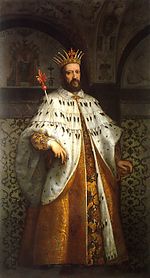
TheGrand Duchy of Tuscanywas an Italianmonarchythat existed, with interruptions, from 1569 to 1860, replacing theRepublic of Florence.[6]The grand duchy's capital wasFlorence.In the 19th century the population of the Grand Duchy was about 1,815,000 inhabitants.[7]
Having brought nearly allTuscanyunder his control after conquering theRepublic of Siena,Cosimo I de' Medici,was elevated by apapal bullofPope Pius Vto Grand Duke of Tuscany on August 27, 1569.[8][9]The Grand Duchy was ruled by theHouse of Mediciuntil the extinction of its senior branch in 1737. While not as internationally renowned as the old republic, the grand duchy thrived under the Medici and it bore witness to unprecedented economic and military success underCosimo Iand his sons, until the reign ofFerdinando II,which saw the beginning of the state's long economic decline. It peaked underCosimo III.[10]
Francis Stephen of Lorraine,acognaticdescendant of the Medici, succeeded the family and ascended the throne of his Medicean ancestors. Tuscany was governed by a viceroy,Marc de Beauvau-Craon,for his entire rule. His descendants ruled, and resided in, the grand duchy until its end in 1859, barring one interruption, whenNapoleonBonaparte gave Tuscany to theHouse of Bourbon-Parma(Kingdom of Etruria,1801–1807), then annexed it directly to theFirst French Empire.Following the collapse of the Napoleonic system in 1814, the grand duchy was restored. TheUnited Provinces of Central Italy,a client state of theKingdom of Sardinia,annexed Tuscany in 1859. Tuscany was formally annexed to Sardinia in 1860, as a part of theunification of Italy,following a landslide referendum, in which 95% of voters approved.[11][12]
Demography[edit]
| Year | Pop. | ±% |
|---|---|---|
| 1861 | 3,627,000 | — |
| 1871 | 4,734,000 | +30.5% |
| 1881 | 4,913,000 | +3.8% |
| 1901 | 5,757,000 | +17.2% |
| 1911 | 6,200,000 | +7.7% |
| 1921 | 6,666,000 | +7.5% |
| 1931 | 7,199,000 | +8.0% |
| 1936 | 7,634,000 | +6.0% |
| 1951 | 8,633,879 | +13.1% |
| 1961 | 9,361,244 | +8.4% |
| 1971 | 10,278,806 | +9.8% |
| 1981 | 10,783,100 | +4.9% |
| 1991 | 10,892,024 | +1.0% |
| 2001 | 10,886,776 | −0.0% |
| 2011 | 11,598,055 | +6.5% |
| 2021 | 11,724,035 | +1.1% |
| Source:ISTAT | ||
In 2023, the population resident in central Italy amounts to 11,680,843 inhabitants.[1]
Regions[edit]
| Region | Capital | Inhabitants |
|---|---|---|
| Rome | 5,703,289 | |
| Ancona | 1,478,881 | |
| Florence | 3,647,054 | |
| Perugia | 851,619 |
Most populous municipalities[edit]

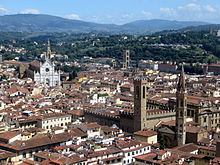

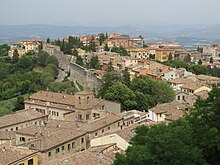
Below is the list of the population residing in 2023 in municipalities with more than 50,000 inhabitants.[1]
| # | Municipality | Region | Inhabitants |
|---|---|---|---|
| 1 | Rome | 2,746,639 | |
| 2 | Florence | 360,444 | |
| 3 | Prato | 195,906 | |
| 4 | Perugia | 161,375 | |
| 5 | Livorno | 152,138 | |
| 6 | Latina | 127,321 | |
| 7 | Terni | 106,121 | |
| 8 | Ancona | 98,292 | |
| 9 | Arezzo | 96,176 | |
| 10 | Pesaro | 95,352 | |
| 11 | Guidonia Montecelio | 89,191 | |
| 12 | Pistoia | 89,000 | |
| 13 | Pisa | 88,726 | |
| 14 | Lucca | 88,724 | |
| 15 | Fiumicino | 81,855 | |
| 16 | Grosseto | 81,154 | |
| 17 | Aprilia | 74,240 | |
| 18 | Massa | 65,933 | |
| 19 | Viterbo | 65,927 | |
| 20 | Pomezia | 64,246 | |
| 21 | Viareggio | 60,416 | |
| 22 | Carrara | 59,786 | |
| 23 | Fano | 59,732 | |
| 24 | Anzio | 58,946 | |
| 25 | Foligno | 55,068 | |
| 26 | Tivoli | 54,908 | |
| 27 | Siena | 52,657 | |
| 28 | Velletri | 52,542 | |
| 29 | Civitavecchia | 51,678 |
Languages[edit]
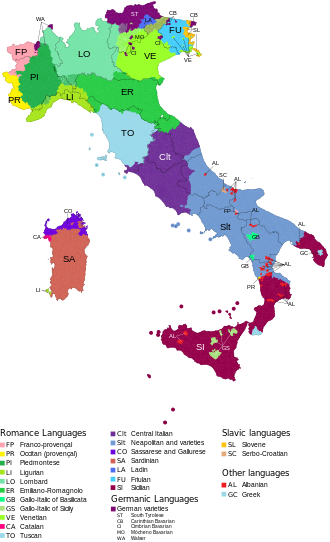
Central Italy is dominated byCentral ItalianandTuscan dialect.Other languages spoken are Gallo-Piceno ( "Gallo-Italic Marche" or "Gaul-Marche" ), aGallo-Italic languagespoken in theprovince of Pesaro and Urbinoand in the northern part of theprovince of Ancona,Marcheregion,[13]andNeapolitan,spoken in southernLazioand in southernMarcheas well as eastern fringes ofUmbria.
Central Italianrefers to the dialects ofItalo-Romancespoken in the so-calledArea Mediana,which covers a swathe of the central Italian peninsula.Area Medianais also used in a narrower sense to describe the southern part, in which case the northern one may be referred to as theArea Perimediana,a distinction that will be made throughout this article. The two areas are split along a line running approximately fromRomein the southwest toAnconain the northeast.[14]In the early Middle Ages, central Italian extended north intoRomagnaand covered all of modern-dayLazio,Abruzzo,andMolise.Since then, however, the dialects spoken in those areas have been assimilated intoGallo-Italicandsouthern Italo-Romancerespectively.[15]In addition, thedialect of Romehas undergone considerable Tuscanization from the fifteenth century onwards, such that it has lost many of its central Italian features.[16][17]
Tuscan dialectis a set ofItalo-DalmatianvarietiesofRomancespoken inTuscany,Corsica,andSardinia.Standard Italianis based on Tuscan, specifically on itsFlorentine dialect,and it became the language of culture throughout Italy[18]due to the prestige of the works byDante Alighieri,Petrarch,Giovanni Boccaccio,Niccolò Machiavelli,andFrancesco Guicciardini.It would later become the official language of all theItalian statesand of theKingdom of Italywhen it was formed.Corsicanon the island ofCorsicaand the Corso-Sardinian transitional varieties spoken in northernSardinia(GallureseandSassarese) are classified by scholars as a direct offshoot from medieval Tuscan,[19]even though they now constitute a distinct linguistic group.
Politics[edit]
Marche,Tuscany,andUmbria,together withEmilia-Romagna,are considered to be the most left-leaning regions in Italy, and together are also referred to as the "Red Belt".[20][21][22][23]
Economy[edit]
Thegross domestic product(GDP) of the region was 380.9 billion euro in 2018, accounting for 21.6% of Italy's economic output. The GDP per capita adjusted for purchasing power was 31,500 euro, or 105% of the EU27 average the same year.[24]
Culture[edit]

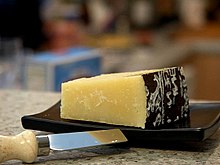
The regions of central Italy were exposed to different historical influences, which were due to the peoples that settled there, such as theCelts,theEtruscans,theNorth Picenes,theSouth Picene,theUmbri,theLatins,theRomans,theByzantinesand theLombards.Some of its woodlands and mountains are preserved in severalNational Parks;a major example is theAbruzzo, Lazio and Molise National Park,located in theAbruzzoregion, with smaller parts inLazioandMolise.It is the oldest in theApennine Mountains,and the second oldest in Italy, with an important role in the preservation of endemic species such as theItalian wolf,Abruzzo chamoisandMarsican brown bear.
Central Italy has many major tourist attractions, many of which are protected by UNESCO. Central Italy is possibly the most visited in Italy and contains many popular attractions as well as sought-after landscapes.Romeboasts the remaining wonders of theRoman Empireand some of the world's best-known landmarks, such as theColosseum.Florence,regarded as the birthplace of theItalian Renaissance,isTuscany's most visited city, whereas nearby cities likeSiena,Pisa,ArezzoandLuccaalso have rich cultural heritage.Umbria's population is small, but it has many important cities such asPerugiaandAssisi.For similar reasons, Lazio and Tuscany are some of Italy's most visited regions and the main targets forEcotourism.This area is known for its picturesque landscapes and attracts tourists from all over the world, including Italy itself. Pristine landscapes serve as one of the primary motivators for tourists to visit central Italy, although there are others, such as a rich history of art.
Roman cuisinecomes from theItaliancity ofRome.It features fresh, seasonal and simply-prepared ingredients from theRoman Campagna.[25]These includepeas,globe artichokesandfava beans,shellfish, milk-fed lamb andgoat,and cheeses such aspecorino romanoandricotta.[26]Olive oilis used mostly to dress raw vegetables, whilestrutto(porklard) and fat fromprosciuttoare preferred for frying.[25]The most popular sweets in Rome are small individual pastries calledpasticcini,gelatoand handmade chocolates and candies.[27]Special dishes are often reserved for different days of the week; for example,gnocchiis eaten on Thursdays,baccalà(salted cod) on Fridays, andtrippaon Saturdays.
See also[edit]
- National Institute of Statistics (Italy)
- NUTS statistical regions of Italy
- Italian NUTS level 1 regions:
- Northern Italy
- Southern Italy
References[edit]
- ^abc"Bilancio demografico e popolazione residente per sesso al 30 giugno 2023"(in Italian).Retrieved25 September2023.
- ^Source:Touring Club Italiano(TCI), "Atlante stradale d'Italia".1999–2000 TCI Atlas.ISBN88-365-1115-5(Northern Italy volume) –ISBN88-365-1116-3(Central Italy volume) –ISBN88-365-1117-1(Southern Italy volume)
- ^Source:De Agostini,"Atlante Geografico Metodico".ISBN88-415-6753-8
- ^Source:Enciclopedia Italiana "Treccani"
- ^ab"Papal States".Encyclopædia Britannica.30 April 2020.Archivedfrom the original on 5 October 2021.Retrieved11 August2021.
- ^Strathern, Paul (2003).The Medici: Godfathers of the Renaissance.London: Vintage.ISBN978-0-09-952297-3.pp. 315–321
- ^Ministry of Agriculture, Industry and Commerce (1862).Popolazione censimento degli antichi Stati sardi (1. gennaio 1858) e censimenti di Lombardia, di Parma e di Modena (1857–1858) pubblicati per cura del Ministero d'agricoltura, industria e commercio: Relazione generale con una introduzione storica sopra i censimenti delle popolazioni italiane dai tempi antichi sino all'anno 1860. 1.1(in Italian). Stamperia Reale.
- ^"bolla papale di Pio V".archeologiavocidalpassato(in Italian).Retrieved10 February2021.
- ^"Cosimo I | duke of Florence and Tuscany [1519–1574]".Encyclopedia Britannica.Retrieved10 February2021.
- ^"COSIMO III de' Medici, granduca di Toscana".Dizionario Biografico(in Italian).Retrieved25 April2020.
- ^François Velde (4 July 2005)."The Grand-Duchy of Tuscany".heraldica.org.Retrieved19 August2009.
- ^Acton, p. 254
- ^Francesco Avolio,Dialetti,inEnciclopedia Treccani,2010.
- ^Loporcaro, Michele & Paciaroni, Tania. 2016. The dialects of central Italy. In Ledgeway, Adam & Maiden, Martin (eds.),The Oxford guide to the Romance languages,228–245. Oxford University Press, p. 228
- ^Loporcaro & Panciani 2016: 229–230
- ^Vignuzzi, Ugo. 1997. Lazio, Umbria, and the Marche. In Maiden, Martin & Parry, Mair (eds.),The dialects of Italy,London: Routledge, pp. 312-317
- ^Loporcaro & Panciani 2016, pp. 229-233
- ^"storia della lingua in" Enciclopedia dell'Italiano "".treccani.it.
- ^Harris, Martin; Vincent, Nigel (1997).Romance Languages.London: Routlegde.ISBN0-415-16417-6.
- ^"'Italians first': how the populist right became Italy's dominant force ".The Guardian.1 December 2018.
- ^Roy Palmer Domenico (2002).The Regions of Italy: A Reference Guide to History and Culture.Bloomsbury Academic. p. 313.ISBN9780313307331.
- ^"Italy's EU election results by region: Who won where?".The Local.27 May 2019.
- ^Publications, Europa Europa (2002).Western Europe 2003.Psychology Press. p. 362.ISBN9781857431520.
- ^"Regional GDP per capita ranged from 30% to 263% of the EU average in 2018".Eurostat.
- ^abBoni (1930), pg. 13.
- ^Boni (1930), pg. 14
- ^Eats, Serious."Gina DePalma's Guide To Rome Sweets".sweets.seriouseats.Retrieved14 November2017.
